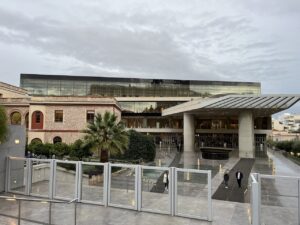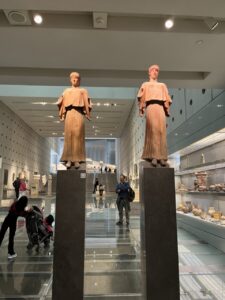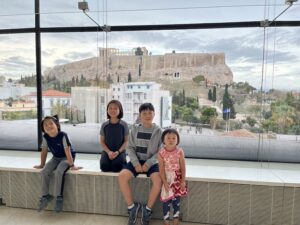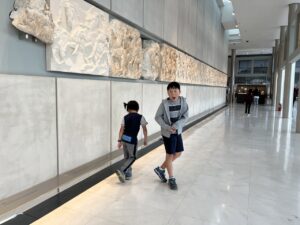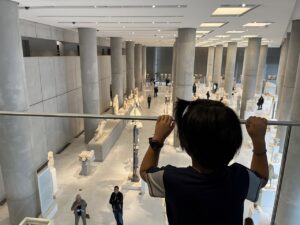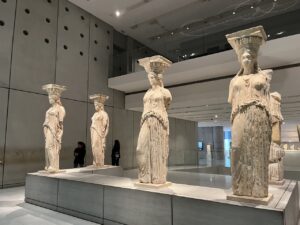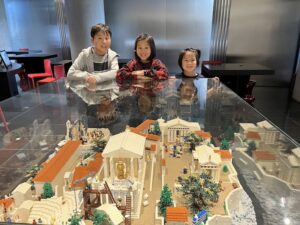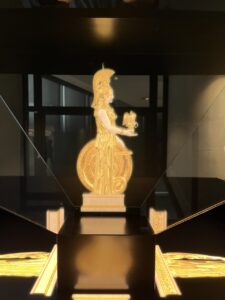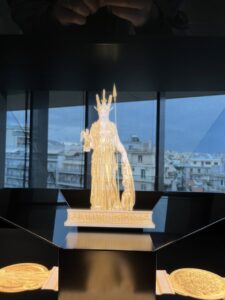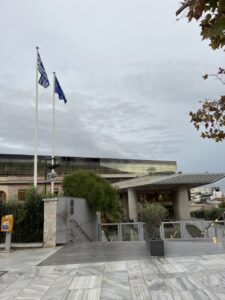Visiting museums can be mentally taxing as they require a great deal of focus and concentration. During our first few days in Athens, we didn’t feel up to visiting a serious museum because we were still recovering from our schedule of intense sightseeing in Egypt. We probably still weren’t ready, but on our last day in Athens, we just had to make it work. The kids were not keen to see the museum with a guide so we decided to venture in, wander and browse at our own pace. I was pleased to find a free audio guide that can be accessed directly from a cell phone.
The Acropolis Museum is a completely modern building situated near the base of the Acropolis. The museum exclusively contains items found on the slopes of the Acropolis or on the “Sacred Rock”. In fact, every significant artifact ever discovered on the Acropolis that remains in Greece is on display at the Acropolis Museum. You can say that it is an extension of the historical site itself. The museum is artfully designed and thoughtfully planned so visitors can see up close the sculptures, reliefs and daily tools that were discovered starting from the Greek Bronze Age through to the Roman times and Byzantine era.
As we approached the museum, we saw that it is perched on concrete cylindrical pillars to protect the excavation site of a Roman or Byzantine neighborhood that lies beneath the museum.
The museum is made of glass, concrete and steel which presents a striking contrast to the ancient marble and clay objects on display inside. In total, there are three exhibition floors of the museum (ground, first and top floors). The first thing we saw when we entered the ground floor exhibition area was a pair of clay statues of Nike, the goddess of victory, which date back to around 1 – 2 AD. The floor slopes upward to mimic walking up the slope of the Acropolis.
We didn’t know it at the time, but visitors are recommended to begin their visit of the Museum on the top floor and descend back down. The reason is because the top floor contains the highlight of the entire museum, the Parthenon marbles, which means the marble reliefs and sculptures that once adorned the walls and roof of the Parthenon itself.
If you look at exterior photos of the museum, you can see that the top floor sits slightly askew from the rest of the building. The reason is so that it mimics the same orientation as the Parthenon. The ancient relics are displayed facing the same direction and in the same sequence and composition as they would have been in the Parthenon, except that they are displayed closer to eye level. Meanwhile, the tall glass windows invite the eye to glance in the direction of the Acropolis every so often, maintaining a constant connection between the original site and the museum.
I admired the fragments of marble sculptures for a while and imagined how they looked when they were still on the Parthenon. There were so many missing pieces that it only made sense when paired with the models for reconstruction. I spent some time looking at a model for the proposed reconstruction of the west pediment. It tells the story of how Athena became the patron goddess of Athens by producing a more valuable gift, the olive tree, compared to Poseidon’s gift of the sea.
The first floor (second level) of the museum contains sculptures and statues from the Acropolis dramatically positioned on pedestals of varying heights. Five of the famous Caryatids from the Erechtheion are on display here, with an intentional opening left for the sixth Caryatid which is housed at the British Museum.
This level was the kids’ favorite as they discovered a replica of the Acropolis made out of 130,000 Lego bricks. They spent more time examining the Lego Acropolis than they did any other exhibit in the museum. While the older three kids were examining the Lego Acropolis, EY entertained herself at a computer station with stories and games. In a side room, there is a 3D hologram of the statue of Athena that once stood in the Parthenon but has been lost to time.
The ground floor of the museum displays everyday objects used by ancient Greeks and objects found in the cult temples on the slopes of the hill in the era before Pericles’ building spree.
During our visit to the Acropolis Museum, the two older kids ran off every chance they had to wander around on their own. DY was with us part of the time, but only reluctantly. EY sat in the stroller most of the time. We probably didn’t devote as much attention and effort as we could have or should have to a museum of this stature and significance. But I accept that none of us can always be 100 percent. Sometimes we just feel tired and don’t have the energy, no matter how important the place, the site, the temple or the museum.
Traveling for such a long period of time requires energy and endurance. There is little or no routine. There might be nothing familiar around you. You have no friends. For the friends that you make, you know you will have to say goodbye in a few hours or a few days. You have virtually none of your own stuff like toys, books, mementos or household stuff. You are always needing to adapt and improvise. For adults and kids, it can be mentally taxing.
So, it’s ok if we take it a little easy and give ourselves a bit of a break. Sometimes we need it. Next time we come back to Athens, we will be ready for a more serious visit to the Acropolis Museum.
Author
-

Song is the mother of four children. She and her family have stepped away from it all and in September 2023, began traveling the world while homeschooling. Song is an ABC (American born Chinese) and has an undergraduate degree from Cornell and an MBA from Harvard. She is an entrepreneur and an educator. Her hobbies include learning, traveling, reading, cooking and baking, and being with children.


